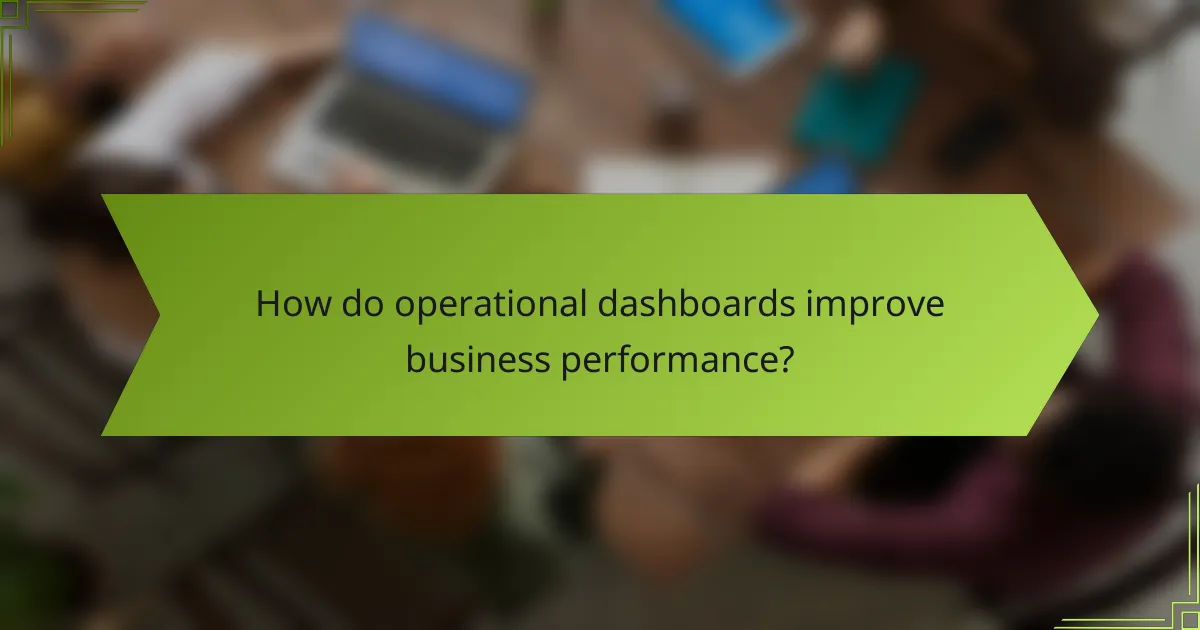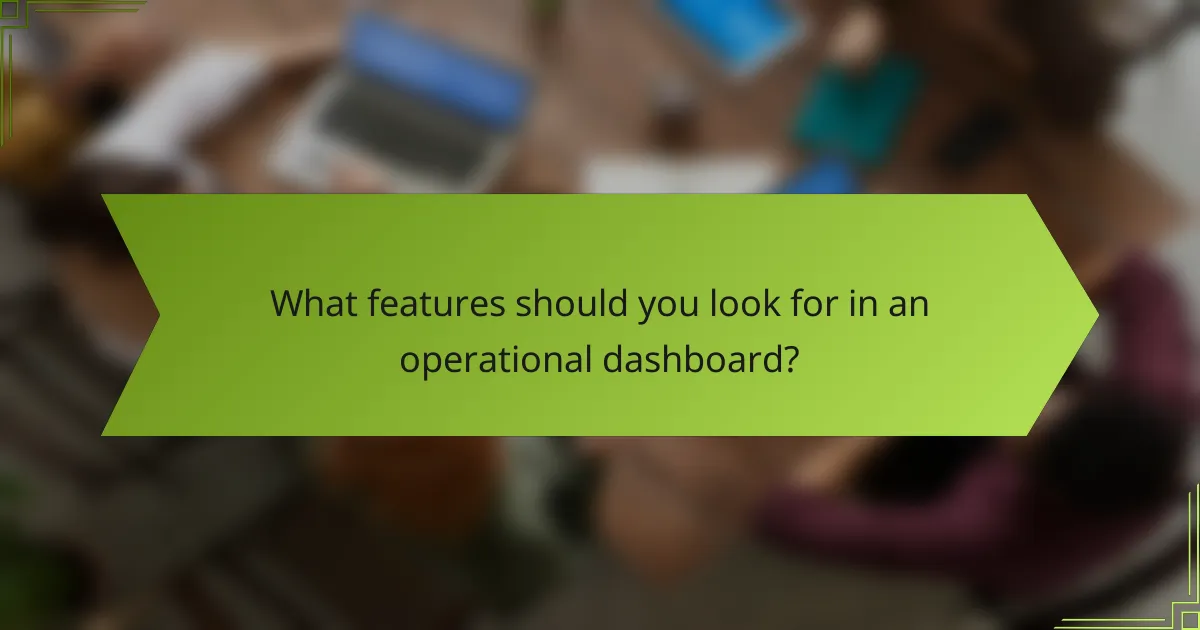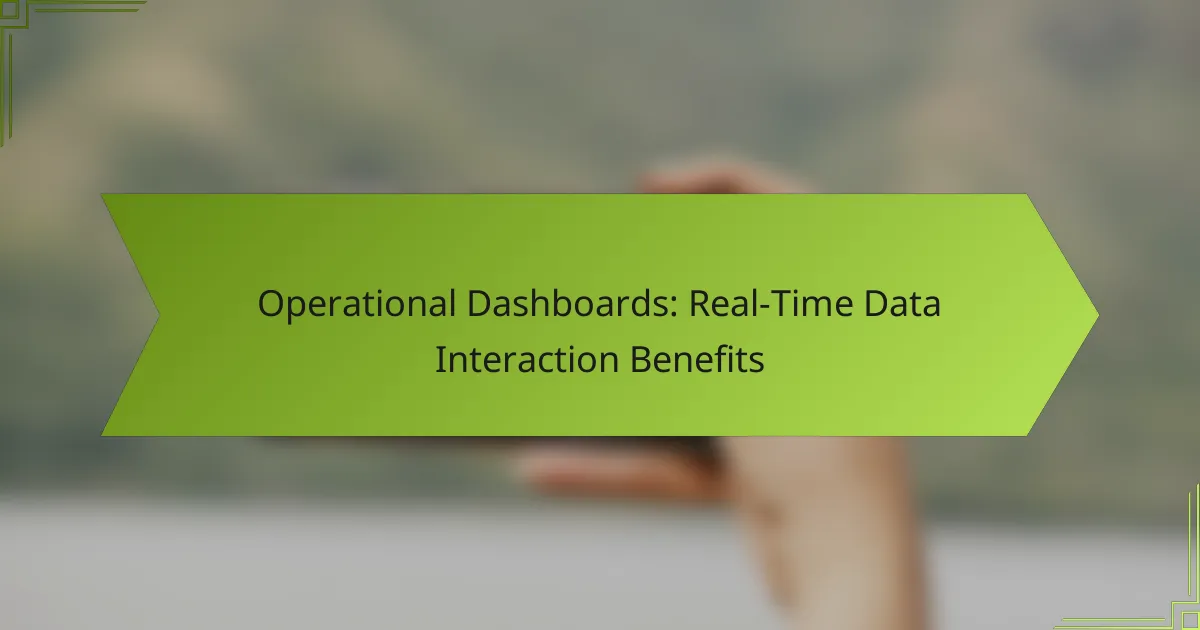Operational dashboards are essential tools that enhance real-time data interaction, delivering immediate insights to support informed decision-making. By aggregating and visualizing key performance indicators (KPIs), these dashboards enable organizations to monitor operations continuously, respond swiftly to changing conditions, and optimize overall performance.

What are the benefits of operational dashboards in real-time data interaction?
Operational dashboards enhance real-time data interaction by providing immediate insights that facilitate informed decision-making. They aggregate and visualize key performance indicators (KPIs), allowing users to respond quickly to changing conditions and optimize operations effectively.
Enhanced decision-making
Operational dashboards support enhanced decision-making by presenting critical data in a clear and concise format. Users can quickly analyze trends and patterns, leading to timely and effective choices. For example, a sales dashboard might highlight declining sales in a specific region, prompting immediate strategic adjustments.
To maximize decision-making benefits, ensure that dashboards are tailored to the specific needs of users, focusing on relevant metrics. Regularly update the data to reflect the most current information, which is crucial for maintaining accuracy in decision-making.
Improved operational efficiency
By streamlining access to vital information, operational dashboards significantly improve operational efficiency. They eliminate the need for manual data gathering, allowing teams to focus on analysis and action rather than data collection. This can lead to faster response times and reduced operational costs.
Consider implementing automated data feeds to keep dashboards current. This reduces the risk of human error and ensures that all team members are working with the same up-to-date information, further enhancing overall efficiency.
Increased data visibility
Increased data visibility is a key benefit of operational dashboards, as they centralize information from various sources into one accessible location. This transparency allows stakeholders at all levels to monitor performance metrics and operational health easily.
To enhance visibility, use visual elements like graphs and charts that highlight important data trends. Ensure that the dashboard is user-friendly, so all team members can navigate it without extensive training, fostering a culture of data-driven decision-making.
Real-time performance tracking
Real-time performance tracking enables organizations to monitor their operations continuously and make adjustments as needed. Dashboards provide instant feedback on KPIs, allowing teams to identify issues before they escalate into larger problems.
Utilize alerts and notifications within dashboards to inform users of significant changes or anomalies in performance metrics. This proactive approach helps organizations stay ahead of potential challenges and maintain optimal performance levels.

How do operational dashboards improve business performance?
Operational dashboards enhance business performance by providing real-time insights into key metrics, enabling quicker decision-making and more effective management. These tools allow organizations to monitor operations continuously, identify trends, and respond proactively to challenges.
Streamlined data analysis
Operational dashboards simplify data analysis by consolidating information from various sources into a single view. This integration helps teams quickly interpret complex data sets and identify actionable insights without sifting through multiple reports.
For example, a retail business can use a dashboard to track sales data across different locations, allowing managers to pinpoint underperforming stores and adjust strategies accordingly. This streamlined approach reduces the time spent on data gathering and increases focus on analysis.
Faster response to market changes
With real-time data at their fingertips, businesses can respond swiftly to market fluctuations. Operational dashboards provide alerts and visualizations that highlight significant changes, enabling teams to act quickly rather than relying on outdated information.
For instance, a manufacturing company can monitor supply chain metrics and immediately address delays or shortages, minimizing disruptions. This agility can lead to a competitive advantage, as businesses that adapt quickly often outperform slower counterparts.
Better resource allocation
Operational dashboards facilitate better resource allocation by providing insights into where resources are most needed. By visualizing performance metrics, organizations can identify areas that require additional support or investment.
For example, a service provider can analyze customer service response times and allocate more staff to peak hours, improving overall efficiency. This strategic allocation helps optimize operational costs and enhances service delivery.

What features should you look for in an operational dashboard?
When selecting an operational dashboard, prioritize features that enhance real-time data interaction, such as customizable visualizations, seamless integration with existing systems, and a user-friendly interface. These elements ensure that the dashboard effectively meets your organization’s needs and improves decision-making processes.
Customizable data visualizations
Customizable data visualizations allow users to tailor the display of information according to their specific requirements. This flexibility enables teams to focus on the most relevant metrics, whether through graphs, charts, or tables. Look for dashboards that offer drag-and-drop functionality and a variety of visualization types to suit different data sets.
Consider the ability to adjust color schemes, layouts, and data filters. This adaptability can significantly enhance user engagement and comprehension, making it easier to spot trends and anomalies in real time.
Integration with existing systems
Integration with existing systems is crucial for an operational dashboard to function effectively. A dashboard that connects seamlessly with your current software, such as ERP or CRM systems, ensures that data flows smoothly and is updated in real time. This reduces the risk of data silos and provides a comprehensive view of operations.
When evaluating integration capabilities, check for compatibility with APIs and data sources you already use. A dashboard that supports multiple data formats (like CSV, JSON, or XML) can enhance its utility and streamline workflows.
User-friendly interface
A user-friendly interface is essential for maximizing the effectiveness of an operational dashboard. The design should be intuitive, allowing users of varying technical expertise to navigate and utilize the dashboard without extensive training. Look for features like customizable layouts and easy-to-access help resources.
Additionally, consider the responsiveness of the interface on different devices. A dashboard that performs well on desktops, tablets, and smartphones ensures that users can access critical data anytime, anywhere, which is vital for timely decision-making.

Which industries benefit most from operational dashboards?
Operational dashboards are particularly advantageous for industries that rely on real-time data to make informed decisions. Key sectors such as healthcare, retail, and manufacturing leverage these tools to enhance efficiency, improve customer satisfaction, and streamline operations.
Healthcare sector
In the healthcare sector, operational dashboards provide critical insights into patient care, resource allocation, and operational efficiency. They enable healthcare providers to monitor key performance indicators like patient wait times, bed occupancy rates, and treatment outcomes in real-time.
For example, a hospital can use dashboards to track emergency room traffic and adjust staffing levels accordingly. This responsiveness can lead to improved patient experiences and better health outcomes.
Retail industry
The retail industry benefits from operational dashboards by gaining visibility into sales performance, inventory levels, and customer behavior. These dashboards help retailers analyze trends and make data-driven decisions to optimize stock and enhance customer engagement.
For instance, a retail chain can monitor sales data across different locations in real-time, allowing them to identify high-performing stores and replicate successful strategies. This can lead to increased sales and reduced stockouts.
Manufacturing operations
Manufacturing operations utilize operational dashboards to monitor production processes, equipment performance, and supply chain logistics. These tools help manufacturers identify bottlenecks and inefficiencies, enabling timely interventions to maintain productivity.
For example, a factory can track machine performance metrics and receive alerts for maintenance needs, minimizing downtime. Implementing dashboards can lead to significant cost savings and improved output quality.

How to choose the right operational dashboard for your business?
Choosing the right operational dashboard involves understanding your specific business requirements and evaluating available options. Focus on features that enhance real-time data interaction, usability, and integration with existing systems.
Assess business needs
Start by identifying the key metrics and data sources that are critical for your operations. Consider what information your team needs to make informed decisions quickly. For example, a retail business may prioritize sales performance and inventory levels, while a manufacturing firm might focus on production efficiency and downtime.
Engage with stakeholders across departments to gather insights on their data needs. This collaborative approach ensures that the dashboard aligns with the overall business strategy and addresses the unique challenges faced by different teams.
Evaluate vendor options
Research various dashboard vendors to find solutions that fit your requirements. Look for platforms that offer user-friendly interfaces, customizable features, and robust data integration capabilities. Popular options include Tableau, Power BI, and Google Data Studio, each with distinct strengths.
Request demos or trial versions to assess usability and functionality. Pay attention to customer support and training resources, as these can significantly impact your team’s ability to leverage the dashboard effectively.
Consider scalability
Choose a dashboard solution that can grow with your business. Scalability is crucial as your data needs may expand over time. Ensure the platform can handle increased data volume and additional users without compromising performance.
Evaluate whether the vendor offers flexible pricing plans that accommodate growth. For instance, some platforms charge based on the number of users or data connections, which can be beneficial as your organization evolves.

What are the costs associated with implementing operational dashboards?
Implementing operational dashboards involves various costs that can significantly impact a business’s budget. These costs typically include initial setup expenses, ongoing maintenance, and potential training for staff to effectively use the dashboards.
Initial setup costs
Initial setup costs for operational dashboards can vary widely based on the complexity of the system and the specific tools chosen. Businesses may spend anywhere from a few thousand to tens of thousands of dollars, depending on whether they opt for off-the-shelf solutions or custom-built dashboards.
Key components of these initial costs include software licenses, hardware requirements, and integration with existing systems. For example, a mid-sized company might invest around $5,000 to $15,000 for software and integration services, while larger enterprises could see costs exceeding $50,000.
To manage these expenses, consider starting with a phased implementation approach. This allows businesses to spread costs over time and assess the effectiveness of the dashboard before committing to full-scale deployment.
